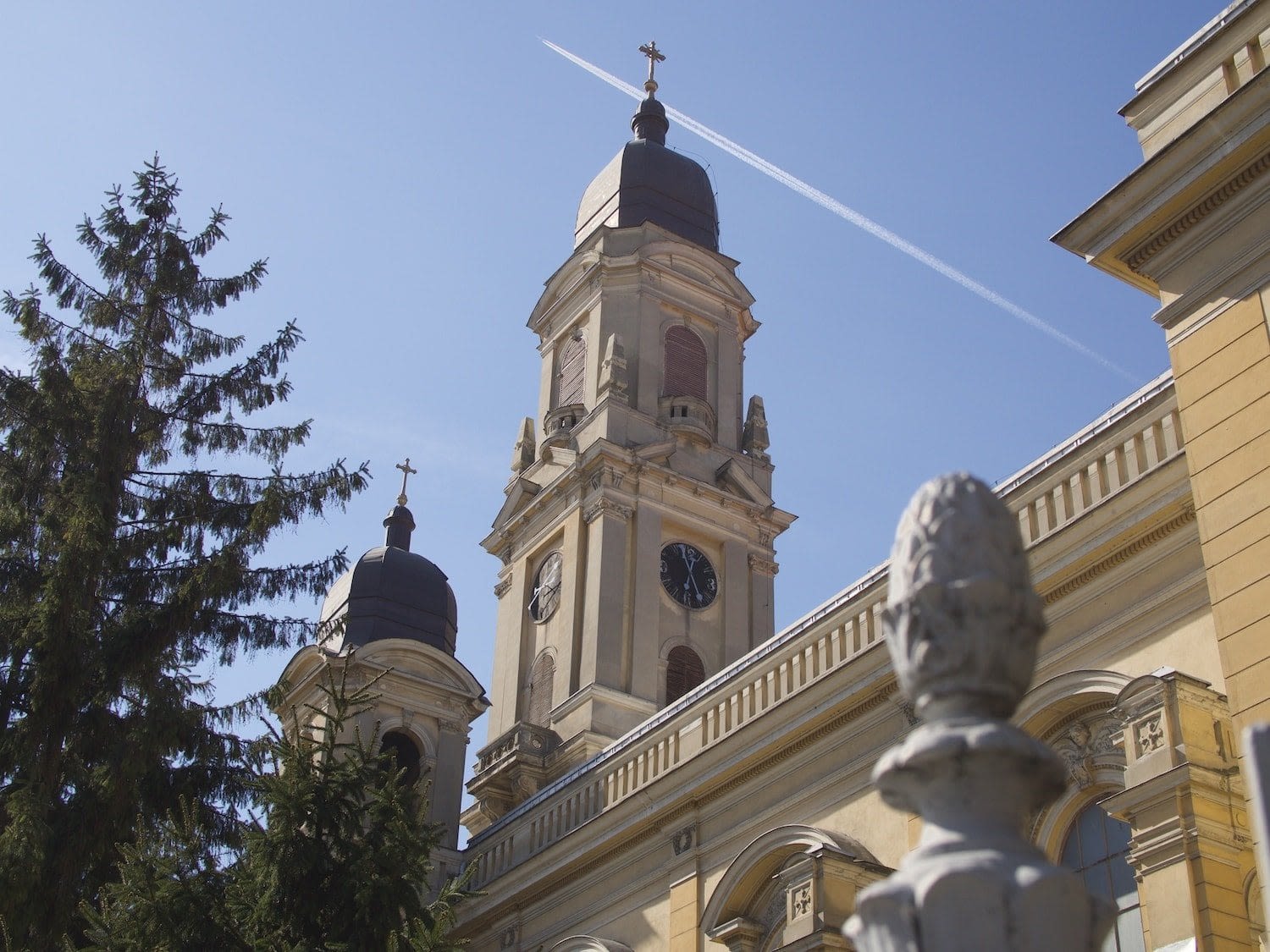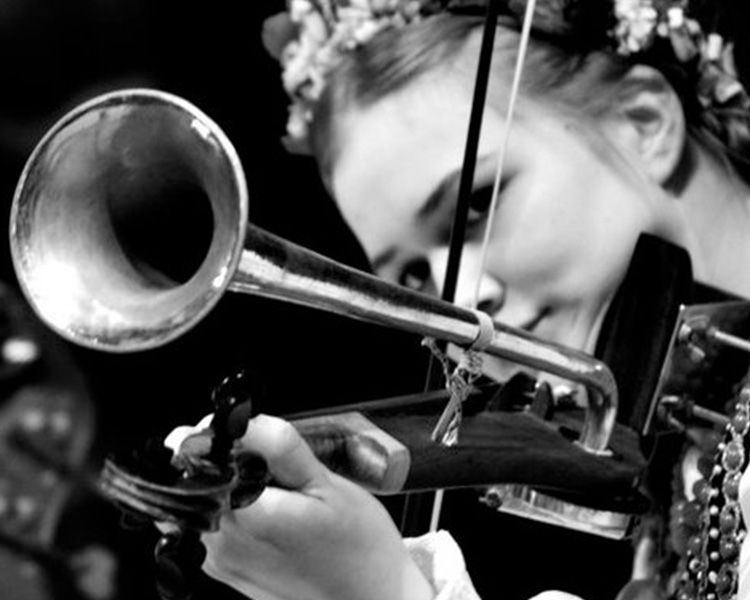Béla Bartók on the
streets of Oradea

Saturdays are wedding days in the Romanian city of Oradea…
Crowds of well-wishers gather outside the Catholic church of St Ladislau, the Town Hall and the Orthodox cathedral. And outside each one, shortly before the bride arrives, a battered taxi typically races up and disgorges an implausibly large number of musicians: clarinettists, drummers, trumpeters, and players of the vioară cu goarnă. The sound they make is raucous, and the dissonances could strip paint. But in Oradea, on a Saturday morning, they make the blood race and the heart leap. It’s not unusual to see passers-by breaking into dance.

A vioară cu goarnă is a folk-fiddle fitted with an antique gramophone horn.
The young Béla Bartók moved to Oradea in 1891. He knew it as Nagyvárad, a lively Hungarian regional city. He would go on to become a leading scholar of Central European folk song, but he would also live to see the whole region transferred to Romania. He died in exile on West 57th Street, Manhattan, in an infinitely stranger world.
'We are beginning to become Americanised', he wrote to his son Péter shortly after arriving in the USA in December 1940.
'In the morning; grapefruit, puffed wheat with cream… My head is bursting with new words of every kind; the names of subway stations and of streets, subway maps.'
On one level, Bartók’s was a very 20th century life – a story of roots and displacement in a changing world. It shouldn’t be hard to empathise. And yet, of all the 20th century’s indisputably great composers, Bartók is still probably the most misunderstood. Audiences in his lifetime saw him as the ultimate Mr Modern, harsh and intimidating. 'As a mathematical proposition, it is astonishingly clever', wrote one British critic of his Third String Quartet in 1929. 'As a musical entertainment it contains not one bar of melody.'

We know better now… don’t we?
While Stravinsky, Schoenberg and even Stockhausen have all found devoted followers, Bartók is still (ask any marketer) a tough sell. Myths die hard. Yet no modernist composer speaks more thrillingly, more boldly and more movingly. Once, that is, you’ve found the right key and turned it in the door.
I found a key on the streets of Oradea. If you’ve yet to find yours, perhaps I can offer a few hints…
Tradition goes two ways
Bartók was devoted to the vanishing world of folk music, but his interest was neither nationalist nor conservative: like Vaughan Williams in the UK, he saw folk song as the seed of a new musical language. Brilliant, high speed clusters of notes; the snap of a plucked string against wood (it’s now called 'Bartók pizzicato'); repetitive, driving rhythms – the sounds that Bartók heard while collecting folk tunes have become part of the vocabulary of musical modernism.
But he never simply appropriates folk culture. When his Dance Suite was premiered in Budapest in 1923, listeners assumed it was a medley of Hungarian folk dances. In fact, Bartók later explained, it contained influences from Hungary, Romania and Algeria, but the melodies were entirely his own.

Open ears mean open hearts
Central Europe between the wars was no place for a champion of multiculturalism. Bartók’s study of folk music, however, convinced him that 'the continuous give and take of melodies, a constant crossing and recrossing' of cultures created the richest and most beautiful melodies – in other words, music thrives on diversity.
Bartók was endlessly curious. As a student, he made a piano version of Richard Strauss’s Ein Heldenleben. In December 1909, in Paris, he asked to meet Debussy. His host demurred. 'But he is a horrid man, he will certainly be rude to you. Do you want to be insulted by Debussy?' 'Yes' said Bartók.

Trust the composer
Bartók’s own music embraces, assimilates and transforms everything it encounters. His opera Duke Bluebeard’s Castle weds the imagery of old Szekler ballads to the psychology of Freud; its music is as opulent as Strauss, as subtle as Debussy, and as haunting as a shepherd’s pipe on a Carpathian hillside.
Szeklers are a subgroup of Hungarian people living mostly in the Székely Land in Romania.
The Concerto for Orchestra begins as rigorously as Beethoven and ends with a high-speed folk dance frenzy, interspersed with fanfares, fugues and a spoof of a barrel organ. Yet it feels like a whole orchestra dancing wildly for joy. The power of Bartók’s creative personality holds it all tightly together – and few 20th century composers make a more compelling argument.
Push those doors
In Duke Bluebeard’s Castle, an inquisitive bride urges her reluctant husband to open seven locked doors. The possible interpretations are endless: gothic horror, feminist parable, even a metaphor for the First World War, which was raging when Bluebeard was premiered in Budapest in May 1918, and which would change Hungary forever. But the gorgeous orchestral colours with which Bartók paints everything from a lake of human tears to a flower stained with blood leave little doubt that whatever it all means, Bartók is speaking from the heart.
'Bluebeard’s castle is not a real castle of stone', wrote Bartók’s librettist, Béla Balász.
'The castle is his soul.'

For the intelligent, idealistic, fiercely private Bartók, writing music was like opening a portal into his own being: an act of courage and utter sincerity. The strangeness, the roughness, the intellectual brilliance and the aching desolation of his works are simply the doors we pass through to encounter one of the most passionate, beautiful and uncompromisingly honest personalities in western music.
They open more easily than you might think.
Béla Bartók
In Profile 1881–1945
Born in 1881 in Hungary, Bartók began piano lessons with his mother at the age of five. He studied piano and composition at the Royal Academy of Music in Budapest, where he created a number of works that echoed the style of Brahms and Richard Strauss.
He discovered Austro-Hungarian and Slavic folk music after graduating, travelling extensively with his friend Zoltán Kodály and recording countless ethnic songs and dances which began to influence his own compositions. Kodály also introduced him to the works of Debussy in 1907, the year in which Bartók became Professor of Piano at the Budapest Conservatory.
Bartók established his mature style with such scores as the ballet The Miraculous Mandarin and his opera Duke Bluebeard’s Castle. He revived his career as a concert pianist in 1927, when he gave the premiere of his First Piano Concerto in Mannheim.
Bartók detested the rise of fascism and in October 1940, he quit Budapest and travelled to the US. At first, he concentrated on ethno-musicological research, but eventually returned to composition and created a significant group of ‘American’ works, including the Concerto for Orchestra and his Third Piano Concerto.
His character was distinguished by a firm, almost stubborn refusal to compromise or be diverted from his musical instincts by money or position. Throughout his working life, Bartók collected, transcribed and annotated the folk songs of many countries, a commitment that brought little financial return or recognition, but one which he regarded as his most important contribution to music.
Composer profile by Andrew Stewart
Andrew Stewart is a freelance music journalist and writer. He is the author of The LSO at 90, and contributes to a wide variety of specialist classical music publications.

Coming up this December
Bartók conducted by Kirill Karabits

Rózsa & Bartók
Thursday 9 December 7pm
Barbican Hall
Kirill Karabits conducts Bartók’s Concerto for Orchestra – plus a rare performance of the Violin Concerto by Bartók’s fellow-Hungarian (and Hollywood legend) Miklós Rózsa, played by LSO Leader Roman Simovic.
Half Six Fix: Bartók Concerto for Orchestra
Wednesday 15 December 6.30pm
Barbican Hall
A different way to experience the LSO, with a burst of music to kick-start your evening: one piece introduced by the conductor, a relaxed atmosphere, and digital programme notes to delve deeper into the music while we play.
Notes by Richard Bratby Richard Bratby writes on music and opera for The Spectator, Gramophone and The Arts Desk. He is the author of Forward: 100 Years of the City of Birmingham Symphony Orchestra.
Images: https://lifesimply.rocks/media/posts/130/gallery/oradea-church-holy-spirit-exterior.jpg, https://boacarazvan.wordpress.com/2011/08/22/vioara-cu-goarna

